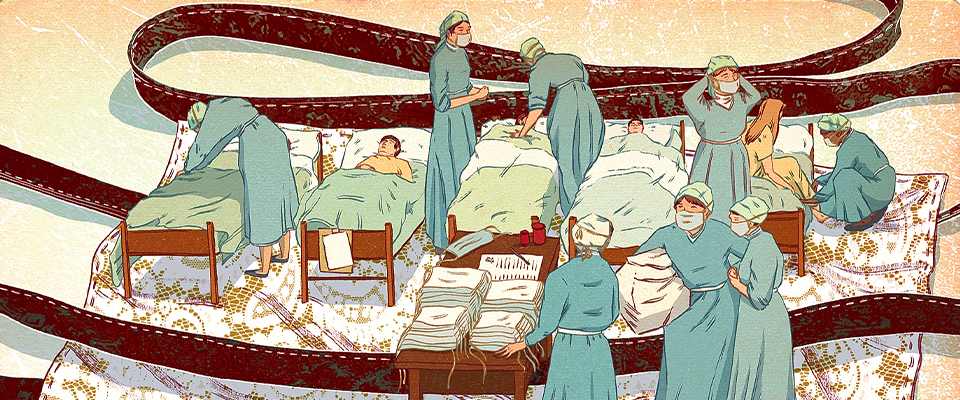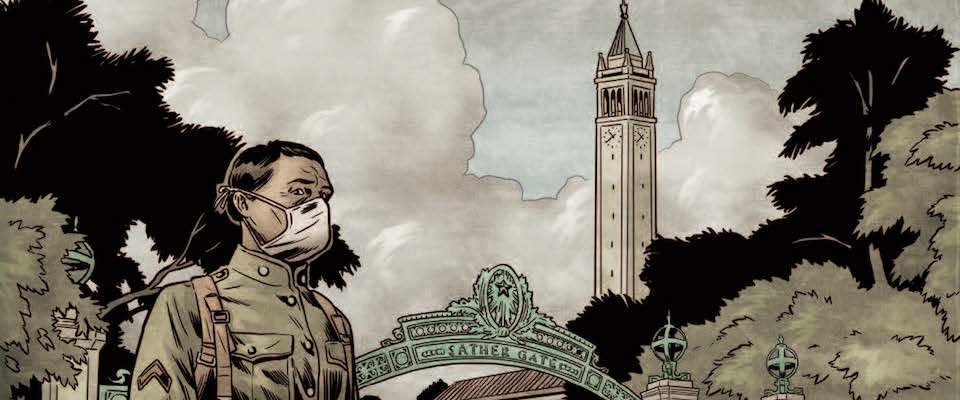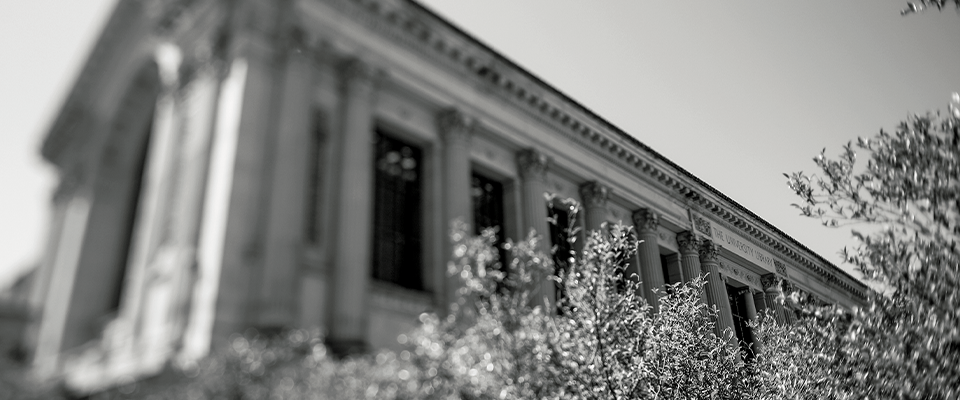IT IS UNCLEAR WHEN AGNES EDWARDS slept. As a sophomore at Berkeley in the fall of 1918, she packed her schedule with social activities. In her letters home to her parents, movies, dances, and hikes with friends mingled with pep rallies and volunteer work at the newly opened Red Cross chapter on campus.
These were the waning days of World War I, and patriotic duty was a way of life. With the University under the jurisdiction of the War Department, campus had been transformed by barracks and training areas, full of thousands of young men in uniforms representing the Army, the Navy, an Ambulance Corps, and more. For women students, a full program of “war courses” provided their contribution to the effort: There were classes in nursing, “First Aid and Home Care of the Sick,” and a burgeoning home economics department focused on nutrition, food rationing, and sanitization methods, under the direction of then-Dean of Women, Lucy Stebbins.
“It would take nearly a century for the women who fought the flu—sewing masks, volunteering as nurses—to receive any recognition at all.”
But as the war raged overseas, a different, arguably more insidious enemy began to appear in Edwards’ letters. “After we’ve washed dishes we’re going to the Red Cross rooms & help make the gauze masks,” she wrote in late October. “Everyone is going to have to wear them tomorrow, even the aviators. The campus will surely be a funny looking place.”
The influenza of 1918—in the parlance of the time, the Spanish Flu—had descended upon the Bay Area. At the time the deadliest virus the world had ever seen, it attacked the young and old, the rich and the poor alike. Before it was done, the influenza would kill more than 50 million people worldwide and shorten the life expectancy of the average American by 12 years. During the war, more American soldiers died from the flu than in battle. At Berkeley, it spread swiftly through the barracks and fraternities, by most estimates infecting some 1,500 people on campus in a matter of a couple months.
These were also months in which Edwards’ male peers would return from war, fêted for their heroism. But it would take nearly a century for the women who fought the flu—sewing masks, volunteering as nurses, and throwing themselves in harm’s way to serve their male peers—to receive any recognition at all.
On Oct. 21, as scientists worked to understand how the mysterious illness spread, University President Benjamin Wheeler issued an order requiring everyone on campus to wear gauze masks. (The City of Berkeley would shortly follow suit, with $500 fines for transgressors.) Of course, that meant that someone had to make the things. That someone turned out to be women, who, responding to nuanced Daily Californian headlines like “A CALL FOR WOMEN,” sewed and distributed nearly 25,000 masks in less than a month. “The unsung heroines of the 1918 influenza epidemic at Berkeley were the women,” wrote historian Rex Adams in the 1998 Chronicle of the University of California.

Under Stebbins and a handful of other female administrators, women also volunteered as nurses in makeshift infirmaries and patients’ homes, tending to the ill with little if any preparation or oversight. One Daily Californian story reported on the results of a door-to-door effort to recruit women with any nursing experience whatsoever: “The workers found many women with nursing experience who were not using their training at present and had failed to realize the importance of registering for service.”
That women worked tirelessly to fight the epidemic is hardly up for debate, says Catherine Gallagher, professor emerita in the English department and co-chair of the history steering committee for the “150 Years of Women at Berkeley” project. It’s also true that the degree to which they sacrificed their own safety for that of their male peers cannot be overstated.
“It’s kind of amazing that more of them didn’t die, frankly,” says Gallagher, noting that the lack of housing for women compounded the issue. (Organizations that provided residences, like ASUC, served men only. Aside from social and civic clubs, women were largely dispersed and isolated, many of them commuting from their parents’ homes.) “Women were not treated. There were women in critical condition, lying in their boarding houses, just kind of watched over by the girl in the next room.
“Some of the sickest ones were out there volunteering to take care of men in their barracks,” she adds. “There certainly weren’t any men coming into women’s rooms to take care of them.”
Women volunteers were thanked. Occasionally. The prevailing attitude expected such work to the point of exacting shame upon those perceived to be slacking.
At least four campus women died while nursing others: two professional nurses and two “unselfish and devoted” students, Elizabeth Webster and Charlotte Norton, described in the University’s annual report to the governor as having fallen “in the service of their brothers in arms.” Another report mentions the death of one female faculty member, Ethel Taylor, a professor in the home economics department. But the true blast radius of the disease is much tougher to measure, and emerges in anecdotes like that of Walter Steilberg, a professor of structural engineering who lost his wife, his mother, and his infant daughter to the flu in a matter of weeks.
Women volunteers were thanked. Occasionally. A few Daily Californian stories contain statements from Stebbins: “We all appreciate so much the ready co-operation and intelligence of the University women in this emergency,” she told the paper, in a piece on the 8,300 masks that had been completed in a matter of days. More were needed, of course. “Women are urged to work on the masks at Hearst Hall during all their spare hours.”
The prevailing attitude expected such work to the point of exacting shame upon those perceived to be slacking. An outraged letter to the editor in an October 1918 Daily Californian noted that “… during university meetings, the number of idle hands among the women of the student body is appalling,” especially when “there is plenty of free wool for everyone” and “instruction is very willingly given.” (The letter-writer concludes with a recommendation that all women carry knitting supplies at all times.)
Throughout the final weeks of 1918 and the first months of 1919, the flu continued to color daily life in waves. “Everything is closed—schools, churches, movies, etc. All the boys are either sick or in quarantine, so there’s absolutely nothing happening,” laments Edwards in late October, noting, as well, the difficulty of learning French through a mask. A few weeks later, the virus is contained enough that she attends a 10,000-person victory rally at the Greek Theatre celebrating the armistice, and in mid-November, she goes to a party at which attendees celebrate being allowed to remove their masks. By January, it’s back, with yet another mask injunction.
“Historians have noted stubborn social barriers that curiously, suddenly fell away, shifts in gender and even race relations that dovetailed with the flu’s cessation.”
The flu only made a real retreat, it seems, in April of 1919. The final death toll for the campus was 21 people, including two nurses, with more than 7,000 dying in California. It’s a fruitless exercise to speculate on what those figures would look like if it weren’t for the work of volunteer nurses.
But their impact can be seen in other ways. In the century since, some historians have noted stubborn social barriers that curiously, suddenly fell away around this time, shifts in gender and even race relations that dovetailed with the flu’s cessation: while the Army Nurse Corps and American Red Cross had previously only admitted white nurses, for example, the 1918 flu saw those organizations admitting Black nurses for the first time.
“Fighting a war involving all parts of the population always leads to these more integrated sort of communal situations,” says Gallagher. “One of the reasons you see suffrage happen first in the West is the settler mentality—everybody’s on alert, everybody’s needed to build a civilization.”
Women’s volunteer work ultimately served as a wedge for suffragists in passing the 19th Amendment, as well. President Woodrow Wilson never issued a public statement about the influenza, by all accounts wanting nothing to distract from the war. But speaking before Congress in favor of women’s suffrage, he could hardly have been unaware of their service. “We have made partners of the women in this war,” he said in 1918. “Shall we admit them only to a partnership of suffering and sacrifice and toil and not to a partnership of privilege and right?”
At Berkeley, writes Gallagher, “some women apparently felt emboldened enough by their ‘war work’ to use it in protesting against campus symbols of male privilege, such as the Senior Men’s Bench … a group of women dared to sit on it and knit garments for war relief in 1918 while another group invaded the men-only lunch counter.”

As women sewed masks and tended to soldiers in makeshift infirmaries, they were also sowing seeds of a larger shift, ultimately helping to reframe popular perception of nursing and public health as fields worthy of serious attention—and professions that perhaps shouldn’t be foisted upon volunteers. (The University president’s 1919 report to the governor says of the physiology department’s Lillian Moore, who oversaw hundreds of volunteer nurses’ aides: “It would constitute a great advantage to the Infirmary if Dr. Moore’s work could be made permanent.” She was made an assistant professor in 1923.)
The flu also coincided with a period in which women were finally moving into positions of real authority at Berkeley—like Jessica Peixotto, who founded what would later become the School of Social Welfare and who in 1918 became the first woman at Berkeley to be named a full professor. A longtime student of French socialism, Peixotto helped advocate for women who wanted to study subjects such as environmental science and industrialization of waterways, and was part of a movement to look at the effects of poverty on children’s health. “I think she had remarkable foresight,” says Maresi Nerad, director of the Center for Innovation and Research in Graduate Education. In her book Academic Kitchen: A Social History of Gender Stratification at the University of California, Berkeley, Nerad details how hard-won Peixotto’s historic promotion to full professor truly was.
And like Stebbins, who devoted her career to increasing female enrollment, fighting for housing and equitable student associations for women and shifting curricula for women to include more high-level science as opposed to vocational training. “It is not easy to feel the joy of sacrifice and service in pursuing the humdrum routine of education while men are called out to practice new arts, to manage machines more powerful and complex than the world has ever seen and to give their lives for their country,” wrote Stebbins in her 1917-1918 annual report to the University president—evidently frustrated by the limits and expectations placed on women’s educational experience well before the pandemic. “But the women of the University have been faithful to the task imposed upon them.”
The closest thing to a monument to these women might be the Women’s Faculty Club. The first-of-its-kind institution was initially organized in 1919, partly out of necessity: the original Faculty Club served men only, and women faculty literally needed somewhere to have lunch. But it’s likely that Stebbins, Peixotto, and the handful of rising faculty stars they recruited to start the place—like Barbara Armstrong, a law professor who later helped draft the Social Security Act of 1935—were also influenced by the events of the previous year.
Lucy Stebbins was “a wonderful example of iron fist and velvet glove—very sweet on the surface, but determined to get what she wanted.”
“All of a sudden you realize how much you need human companionship,” says Mary Remy, the longtime manager of the club, where a lounge and a live music series (not to mention a scholarship) bear Stebbins’ name. In the words of an early Women’s Faculty Club member, says Remy, Stebbins was “a wonderful example of iron fist and velvet glove—very sweet on the surface, but determined to get what she wanted, and when she was told the men’s faculty club had no place for women, that was it.”
There were social clubs for women, notes Nerad, “but the women who built [the Women’s Faculty Club] had something totally different in mind.” It was a physical space where academic women could bring guests, hold meetings—and organize activities that were meaningful to their careers, that served to advance their professional lives. Importantly, it did not have volunteer service as its primary function.
Lunch with a colleague might not seem revolutionary. But as the letter-writer who chastised women for not knitting during meetings so aptly put it: “A great deal can be accomplished in odd moments.”
Emma Silvers is a Bay Area freelance writer and editor.
From the Fall 2020 issue of California.


















